Cite this document
(“Impact of Globalisation and Innovation on the Business Operating Coursework”, n.d.)
Retrieved from https://studentshare.org/finance-accounting/1416924-impact-of-globalisation-and-innovation-on-the
Retrieved from https://studentshare.org/finance-accounting/1416924-impact-of-globalisation-and-innovation-on-the
(Impact of Globalisation and Innovation on the Business Operating Coursework)
https://studentshare.org/finance-accounting/1416924-impact-of-globalisation-and-innovation-on-the.
https://studentshare.org/finance-accounting/1416924-impact-of-globalisation-and-innovation-on-the.
“Impact of Globalisation and Innovation on the Business Operating Coursework”, n.d. https://studentshare.org/finance-accounting/1416924-impact-of-globalisation-and-innovation-on-the.


